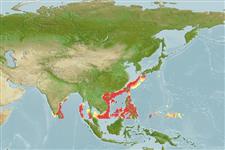Environment: milieu / climate zone / depth range / distribution range
Ecología
marino asociado a arrecife; rango de profundidad 10 - 297 m (Ref. 90102). Tropical; 32°N - 6°N, 30°E - 155°E
Indo-West Pacific: South Africa (off Durban) east to southern Japan, the Caroline Islands, and eastern Australia.
Tamaño / Peso / Age
Maturity: Lm ? range ? - ? cm
Max length : 23.0 cm TL macho / no sexado; (Ref. 4313)
Espinas dorsales (total) : 12; Radios blandos dorsales (total) : 9; Espinas anales: 3; Radios blandos anales: 5. Highly variable in color and in appendages in relation to habitat. Covered with appendages on algae reefs, but plain when deep with sponges (Ref. 48635). Body highly compressed and covered with weed-like tassels (Ref. 37816).
Found in rich soft-bottom habitats in current prone channels (Ref. 48635); also in rocky or coralline habitats near algae where it camouflages itself. Hunts prey at night like other species of scorpaenids, feeding on fish and small invertebrates. Solitary among corals, rocks and weeds (Ref 90102).
Life cycle and mating behavior
Madurez | Reproducción | Puesta | Huevos | Fecundidad | Larva
Myers, R.F., 1991. Micronesian reef fishes. Second Ed. Coral Graphics, Barrigada, Guam. 298 p. (Ref. 1602)
IUCN Red List Status (Ref. 130435: Version 2024-2)
Human uses
Pesquerías: sin interés; Acuario: Comercial
Herramientas
Special reports
Download XML
Fuentes de Internet
Estimates based on models
Preferred temperature (Ref.
123201): 17.5 - 27.2, mean 21 °C (based on 186 cells).
Phylogenetic diversity index (Ref.
82804): PD
50 = 0.5156 [Uniqueness, from 0.5 = low to 2.0 = high].
Bayesian length-weight: a=0.01778 (0.00689 - 0.04588), b=3.04 (2.82 - 3.26), in cm total length, based on LWR estimates for this (Sub)family-body shape (Ref.
93245).
Nivel trófico (Ref.
69278): 4.0 ±0.60 se; based on food items.
Resiliencia (Ref.
120179): Medio, población duplicada en un tiempo mínimo de 1.4-4.4 años (Preliminary K or Fecundity.).
Fishing Vulnerability (Ref.
59153): Low vulnerability (13 of 100).
